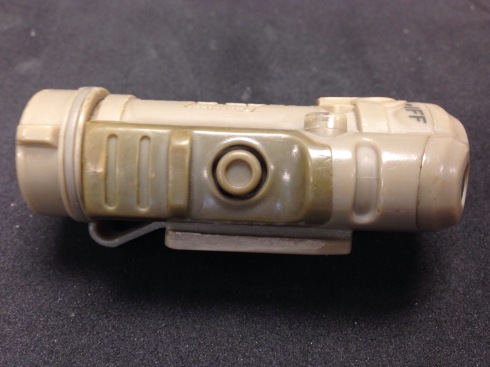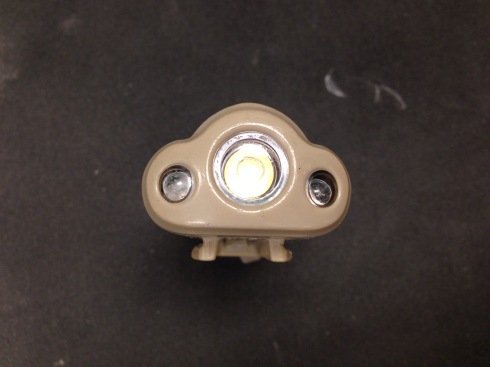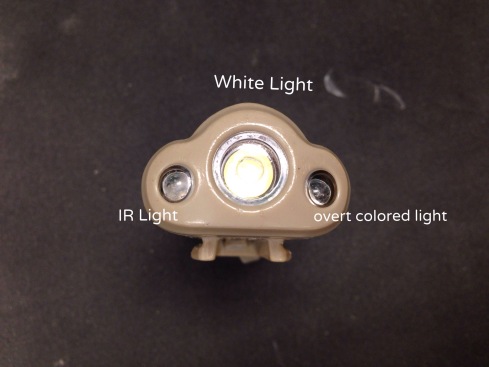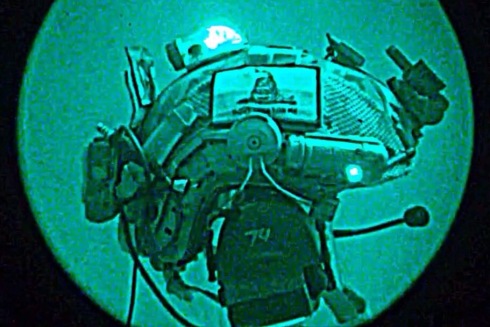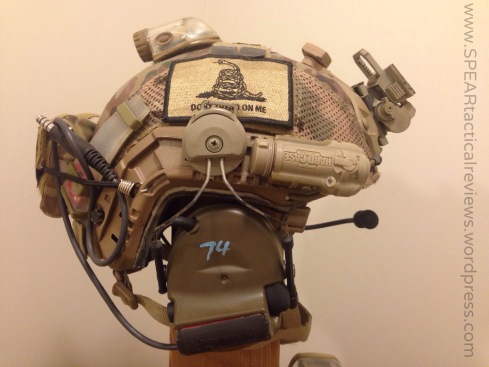Background
Energizer Hard Case Tactical series lights are multi-functional, lightweight and versatile lights designed specifically for use by military personnel. Using the latest in LED technology, infrared and strobing IR for IFF, and discrete switches.
Energizer Hard Case Tactical Tango Helmet Light is described as a compact, and lightweight light built to withstand the rigors of military use. It features six light sources, four visible (White plus Red, Green or Blue) and two night vision infrared (IR + IR IFF), with the added option of a high output flash mode in each of the visible spectrums
I was recently looking for a light that could be attached to the rails on my helmet that would provide more of a than the MPLS which I primarily use for map reading and close proximity illumination. I was initially considering picking up an M-AX mount from S&S Precision particularly since I already carry a Surefire E19. Another consideration I had however was that I needed something that provided some IR illumination to enhance target discrimination while working under NODs. For this I was going to go with an M300V Scout until I came across the Hardcase Tactical Tango.
Feature Highlights
- 2 overt light sources – Primary white light plus a unique feature that allows the user to preprogram the secondary light in either red, green, blue, or red each with 3 variable brightness level settings from high, medium and low)
- Field Programable Primary white with 3 variable brightness settings high medium and low – the simple programming function allows the user to customize the intensity cycle.
- Fleid progaramble IR/IFF – Three flash speeds allows all team members sync their individual IFFs as needed.
- Mounts: helmet picatinny, molle/OTV/MTV, ballcap, headstrap, (ARC rail mount sold separetly)
- IR and Lockout modes prevent other light sources from operating
- Mounts to either side of helmet with a standard screwdriver
- Four light modes: BRIGHT WHITE – High-intensity LED, 35 lumens on high. Dedicated On/Off switch, High/Medium/Low settings, BLUE LED – For light-discipline and medical applications. Dedicated On/Off switch, High/Medium/Low settings, IR – Infrared light for use with night-vision devices. 880 nanometer rating IR STROBE – for Identify Friend or Foe (IFF) capability, Blink rate = 2/second
- Ideal for search operations, hiking, camping, hunting and other outdoor applications
- Switchable to flashing mode in each visible spectrum
- Splash proof design and drop tested to 3m on hard ground
- Integrated IR Illuminator and IR IFF beacon (3 output options) with lockout switch
- Waterproof construction (1 metre for 30 minutes) for harsh and wet weather applications
- User can choose high, medium, low or low, medium, high output modes in the visible spectrum
- LEDs are switchable between high (25m+ range in White), medium and low (close up read/write) intensities in visible spectrum modes
- 6 light sources, 4 visible (White plus Red, Green or Blue) and 2 night vision compatible (IR + IR IFF)
- Ultra compact, lightweight, advanced, rugged polymer construction for durability and precise functionality
- Hand-holdable as a flashlight and supplied with 5 mounts that allow attachment to almost anything in the tactical environment like Helmet, Head, Weapon Rail, Molle, Belt, Cap, Clothing or Vehicle
Manufacturer Specifications
- Infra Red : Lumens 41 High / 18 Medium
- Light Sources: 4x Visible and 2x Infrared
- Battery: 1xAA Lithium or Alkaline Battery
- Dimensions: 75x32x26 mm
- Weight: 48g
Operation and Insights
The basic operation of the Hardcase Tactical Tango is pretty intuitive; the is a raised push button on both sides of the light that, when the center toggle switch is in the center position, will operate both the primary and secondary overt lights. The push button in the middle operates the primary light while the one at the rear operates the secondary colored light. An easy way to remember which is which is to remember, “back is blue”. Each push of the button will cycle through the high, medium, and low intensity settings on the corresponding light, the order of which is customizable.
The Tango utilises a simple programming system that allows you to select the intensity sequence of both the primary and secondary overt lights, as well as choose from any of the four colors (Red, Green, Blue, Red) for the secondary light.
Choosing the color of the secondary light:
- Set operational Toggle Switch (TS) to center position.
- Press the (P) button and
- hold for 5 seconds until
- you see three (3x) RED flashes from the right secondary LED.
- To select the color, simply press the (P) button
- 1X (once) WHITE Primary
- 2X (twice) RED Secondary
- 3X (three) GREEN Secondary
- 4X (four) BLUE Secondary
- The selection will illuminate to indicate which color you are programming.
The push button that activates the primary light also turns the IR omni-directional light on and off when the TS is set to the IR position.
On all the light modes after three seconds of turning the light on, a second push of the button will turn the light off.
The IFF strobe functions much like the IR light, and is activated by pushing the same push button that operates the secondary light when the TS switch is set to the IFF position. The flashing by default starts in the ‘high flash’ mode, one more push of this button with set it to ‘low flash’ mode and another push of the button will set it to “S.O.S” mode. After 3 seconds, another push of this button will revert the mode back to ‘high flash’. Flip the toggle switch to the center position to turn the IFF off.
Thoughts and Insights
What the Tango lacks in overall power it more than makes up for in features. I found it to be brighter and more comfortable in the pocket as well than my E19 with less printing due to its flatter profile. I like the fact that it has variable intensity levels and find the visible spectrum great for times when the white light would be unpleasant. like when rummaging through the contents of my pack while in my tent in the middle of the night. The fact that the user can customise the visible spectrum light is a great feature that makes the tango very adaptable. I personally found the blue light is great for casualty care and allows you to see things like blood and injuries much easier than the more common red LED on many headlamps.
With a mount/adapter for nearly every application I found the Tango to a great all around light. The standard Helmet Mount allows the light to rotate through 360° in 18° increments and locks into desired position. An ARC rail mount is also available but does not come with the standard package. Personally, I found that the ARC rail adapter made it so that the light sticks out the side more than I would have liked. and since I have an MPLS mounted to the other side of my helmet already, my primary use for the Tango would be as an IR illuminator and helmet light I was willing to sacrifice the rotation for a bit of a lower profile. I was able to accomplish this by taking a dremel and shaving about 2mm off the rails on the back of the Tango which allowed me to slide the light directly onto the ARC rails without affecting its ability to still mount on to the various adapter plates.
The Tactical TANGO Helmet Light is IPX7 rated that is, waterproof for 30 minutes in 1m of water and has been drop-tested to 3m on hard ground. The Tacticle light is supplied with an array of mounts, like, an elasticated rotatable Head Strap for simple attachment to head; a rotatable Helmet Mount which allows the light to rotate through 360° in 18° increments and locks into desired position, a Picatinny Mount to attach it to a compatible rail; a Mollé/Vest Mount with integrated magnets to attach it securely to Mollé webbing or a ferromagnetic metallic surface such as a vehicle; and a Cap/Clip Mount which attaches to the brim of a cap or to a tactical vest, pocket, epaulette or belt.
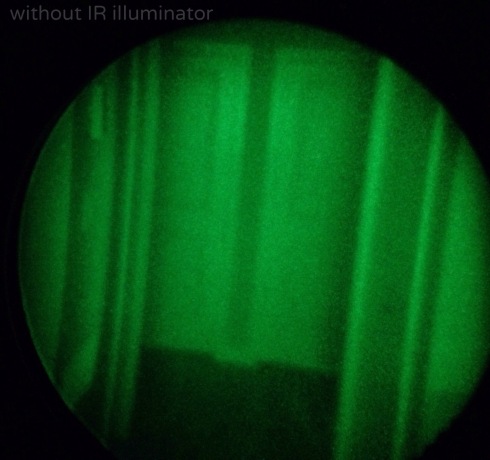

Users manual PDF: https://www.hardcasetactical.com/images/TANGOINSTRUCTIONSFINAL.pdf




